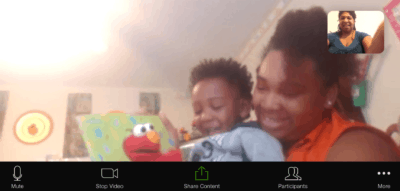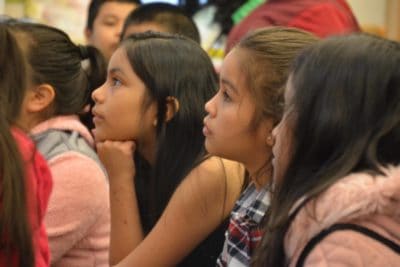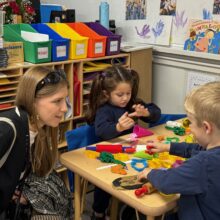EdNC spoke with Dr. Sallie Permar, director of the Children’s Health and Discovery Institute at Duke University Medical School, about the coronavirus pandemic’s impacts on children and children’s role in policy and research as North Carolina reopens. Dr. Permar, who is also a professor of pediatrics, immunology, and molecular genetics and microbiology, says child-centered solutions will be important in overcoming the pandemic. The following conversation has been edited for length and clarity.
Liz Bell: Most people think about COVID-19’s impacts on adults. How is this virus impacting young children physically?
Dr. Permar: As this pandemic has played out across countries throughout the world and now in the U.S., we have a pretty clear pattern that children are the least … contributors to the number of cases, at least that we are testing and finding positive.
Not only are they a minority of the cases that are being diagnosed; they also have the lowest risk of hospitalization of all the age groups in that 0-9 age group, and they have the lowest risk of death. And on top of that … is how few cases of infections in that age group [have resulted] in deaths that have occurred where there were no underlying co-morbidities.
So it’s really playing out that, again, remarkably, children are not having severe acute infections with this virus. They don’t have the same propensity for lung disease that lands you in the ICU and puts you on a ventilator, which is unlike a lot of the viruses that we deal with every year … There’s something about coronaviruses with children where children are mostly protected from severe disease.
One concerning observation that came along in the late surges in cases was the children that were presenting with an inflammatory illness that was recognized as similar to Kawasaki disease, which is an inflammatory syndrome of young children that is characterized by high fever and inflammation. That is a pretty rare diagnosis in pediatrics but something that we see every year.
There was a wave of cases of inflammatory syndrome in children in places that have had high numbers of cases like New York City of those presenting for care. At first, doctors weren’t sure how to treat it because they didn’t really recognize it as a post-infectious complication of coronavirus, because many of the children, being asymptomatic when they had the original infection, never were diagnosed.
But as the pattern started to be recognized that, after a large number of people become infected, then you have these numbers of cases of children who will present with this inflammatory syndrome, people started testing for coronavirus itself or coronavirus antibodies, and finding that many of the children did have evidence at least of previous coronavirus infection, and learned to treat it more like we think about the Kawasaki disease — to treat the inflammation with things like steroids or a treatment for Kawasaki. That has largely worked to treat that disease, and make it a disease that I think physicians now know to recognize it and to treat it accordingly.
There have been some deaths associated with that infection but actually very few. And we don’t know the true number of cases of that infection per number of infected children because we don’t really know the number of infected children, because they don’t present with symptoms. Numbers like 1 in 1,000 have been thrown out, but that’s really not based on a lot of data.
Bell: What about non-physical pandemic impacts, including missed wellness visits and developmental effects?
Dr. Permar: So there has been breakdown in routine health care provision for children, and that’s really documented and most extreme in recognizing how far behind we are in vaccines, and that’s reverberating throughout the world. Vaccine programs that rely on community outreach and interaction with lots of children and people, those programs are just being held because of concerns of spreading the virus. So certainly routine health in children has been impacted.
An untold story is how much rearrangement was made in in-patient systems to make room in all the adult cases. Children were moved out of their own hospitals. Ventilators were provided from children’s hospitals to adult hospitals. Adults were put in pediatric ICUs. Pediatricians were asked to be adult doctors. All of those things that really children gave up for adults — now it was all that could be done because the health system has had to make massive shifts to provide for all these patients, but just recognizing the sacrifices that children had to make, and they’re not a group that can advocate easily for themselves.
Then you come to education and development, and that’s where I’m most concerned right now. What I see, and even in talking to state health providers, is that the metrics that they’re considering for what to do with public schools and other safety practices for schools going back is really adult metrics — how many adults are in the hospital, what’s our death rate, what’s our percentage of cases being tested as positive for all the people getting tested. And there’s not right now, that I see, a consideration for an appropriate metric that is tailored for children for whether children should be in school or not, and I’m very concerned about that.
Sign up for Early Bird, our newsletter on all things early childhood.
Bell: Around 66% of child care centers were already open in June, and schools are figuring out how they are opening in the fall. What would a child-centered metric look like to watch as we reopen these settings?
Dr. Permar: It would be based on data. Right now the data that’s mostly … from other countries that had their rise of cases before us, is when you do put children back in congregate settings, what are the rates of outbreaks in those settings? What are rates of children giving it to each other, or children giving it to adults?
Right now the data is mixed that’s been reported. It both says that children are unlikely transmitters, and some data says that children are likely transmitters. I don’t think we yet have a good handle on what is the risk of children giving it to each other, children giving it to their teachers, and of course children taking it home to their households.
I think with 66% of day care centers open, what needs to be happening right now is intensive study of all of those open day cares to document cases that come not only from the children that are attending but the staff and the households of those children.
It’s not an easy thing to do because often you don’t know was it the adults who got infected first and then the children or vice versa, but there are careful epidemiologic studies, and even studies of the virus that they’re getting infected with itself, to trace it back to who it came from.
We’ve started with day care centers mostly being open — which I think is the right call, because we don’t have enough data in hand to say that shouldn’t be happening, and of course we know that children’s development is dependent on face-to-face interaction, not virtual, for young children. So I think it’s the right call to have day care centers open, but they should be intensively studied and then move up into, as school goes back, studying those groups as well.
We’ve even worked with the YMCA of the Triangle to propose studies of their day camps because parents are going to work and children need supervision, and so they did open their day camps this summer. So that’s a perfect opportunity to start learning what school’s going to look like in the fall, and I don’t see a large-scale effort going on there.
What I’m afraid is that we’re going to treat schools like we do bars and close them down with equal metrics being applied, and I don’t think it’s equal.
Bell: Other than studying congregate settings for children, what practices should be in place as schools and child care centers reopen?
Dr. Permar: There’s a lot of repercussions of testing and looking for cases or even just passively looking for cases.
So what if one child in a classroom, what if their parent gets diagnosed? What should be the protocol for that entire classroom? What if a teacher gets diagnosed and she’s been teaching a classroom? What should be the protocol for that? And we don’t have data to inform all of these decisions.
Because we have such a disparity in the burden of the cases right now, which is mostly in underserved and minority populations, there’s a higher risk that there will be absenteeism that’s driven by looking for cases and looking for preventative assessment of potential cases, that it will cause absenteeism in a different way that members of underserved and minority communities may be required to be absent more often just because there’s a higher burden in their community.
That’s going to take a lot of thought. It’s likely not going to be always driven by data, but we should try.
… That’s also what our policymakers and school leaders can be doing is not just talking amongst themselves but making sure that they’re reaching out to people who have dealt with other viruses and understand the unique features of this virus and getting consensus guidelines that can support children’s education but also safety.
Bell: How can we ensure the strategies we use to open child care centers and schools safely are equitable when different centers and school districts have different resources?
Dr. Permar: That is a challenge. I think it does start with strong federal and state guidelines that do their best to be specific and less vague. Right now we are at a time when masks have been strongly recommended but not required. Those guidelines do leave some things that have to be determined on the local level. So the more specific those guidelines can be, I think the better.
Also, community-engaged research is a way to make sure that communities that don’t have the same resources maybe as the next community can actually be served through research. So research is usually taken on by academic centers and are really people like me who just want to find, what is the right way for us to serve children during this time in a safe way, but recognizing their emotional and education needs.
I think sometimes research is looked at like it’s just serving academia but actually community-engaged research is really seeking to find what is the best practice for places like rural day care centers and schools. So I think community-engaged research is one way that there can be more experts involved in the policies and practices of certain centers in a way that typically doesn’t cost them anything.
… That’s something that’s being funded more and more at the federal level, through the recognition that research cannot just go on at these academic centers. It has to engage with the community. I think that’s a shift in the way we’re doing research, which is positive.
Bell: Why is a child-centered approach important in overcoming this virus for everyone?
Dr. Permar: I do think that while children have a less severe outcome from this infection at least during acute infection, that they are still the source of many respiratory viruses, and that is true of almost every virus that we know, that children are a source where they’re not as careful with when they cough and sneeze. They have to be reminded to wash their hands. They just spread respiratory viruses. That’s what they do.
So I do think that if we’re going to control this virus, we do need to think about immunizing children as a way to stop routes of spread.
Also children are definitively, notoriously the best at getting their vaccines. Any vaccine that is rolled out in a pediatric schedule almost immediately gets greater than 80% coverage, whereas adult-focused vaccines get much lower coverage, less than 50%. Even when we roll out a vaccine in an adolescent population, like the HPV vaccine, which is a very safe and effective vaccine in preventing cancer, we’re only reaching 40 or 50% coverage.
So children clearly are — if we want to have a universal vaccine — they’re clearly the best target for having to reach the majority of the members of that population.
Finally children, despite how we think of them having a developing immune system, which in some ways they do, but one thing they’re very good at is making antibody responses. And antibody responses are going to be the key to the vaccine response that’s going to be needed to protect individuals.
So while we sometimes think we shouldn’t design vaccines for children because they’re not going to make as good of a response because they have a developing immune system, that’s actually the wrong way of thinking, especially when you’re talking about a vaccine that’s focused on antibody responses, like the coronavirus vaccine is and will be.
If you think about, we give the Hepatitis B vaccine soon after delivery, in the first couple months of life, and that vaccine can provide lifelong protection against Hepatitis B, even though you gave it as a baby. So something similar could be achieved with the coronavirus vaccine. But we’ll only know if we test it in children.
I do think it’s clear that the safety testing is going to go on in adults. Vulnerable adults are going to be initial targets, but we can’t leave out children if we’re really going to overcome this pandemic.
… As a pediatrician and as a researcher, I do see that children are often, they’re a vulnerable population that are often left out of initial priorities in research and in policymaking. And they’re a group that can’t advocate for themselves and don’t have resources.
I hope that this pandemic will maybe be a lesson for us on how if you don’t think of that group, even if they’re not the group that are filling ICUs, they’re going to be an important component in ending the pandemic. They’re going to be the ones that have lived through the pandemic the longest. Any effects on them now that make them more vulnerable to later effects, such as education or such as an inflammatory syndrome that makes them more likely to have heart attacks, we’re going to be paying for that for years to come.
Recommended reading




